Margaret Sanger
From Wikipedia, the free encyclopedia
| Margaret Sanger | |
|---|---|

Sanger in 1922
|
|
| Born | Margaret Higgins September 14, 1879 Corning, New York, United States |
| Died | September 6, 1966 (aged 86) Tucson, Arizona, United States |
| Occupation | Social reformer, sex educator, nurse |
| Spouse(s) | William Sanger (1902–1921)[note 1] James Noah H. Slee (1922–1943). |
In 1916, Sanger opened the first birth control clinic in the United States, which led to her arrest for distributing information on contraception. Her subsequent trial and appeal generated enormous support for her cause. Sanger felt that in order for women to have a more equal footing in society and to lead healthier lives, they needed to be able to determine when to bear children. She also wanted to prevent unsafe abortions, so-called back-alley abortions, which were common at the time because abortions were usually illegal.
In 1921, Sanger founded the American Birth Control League, which later became the Planned Parenthood Federation of America. In New York City, she organized the first birth control clinic staffed by all-female doctors, as well as a clinic in Harlem with an entirely African-American staff. In 1929, she formed the National Committee on Federal Legislation for Birth Control, which served as the focal point of her lobbying efforts to legalize contraception in the United States. From 1952 to 1959, Sanger served as president of the International Planned Parenthood Federation. She died in 1966, and is widely regarded as a founder of the modern birth control movement.
Contents
Life
Early life
Sanger was born Margaret Louise Higgins in 1879 in Corning, New York,[3] to Michael Hennessey Higgins, an Irish-born stonemason and free-thinker, and Anne Purcell Higgins, a hard-working, Roman Catholic Irish-American. Both Anne and her parents immigrated to Canada when she was a child, due to the Potato Famine. At 14 Michael Hennessey Higgins immigrated to the USA and when Michael turned 15 he served in the U.S. Army during the Civil War, where he was a drummer. After leaving the army he studied medicine and phrenology, but ultimately chose to become a stonecutter, making stone angels, saints, and tombstones.[4] Michael H. Higgins was a Catholic who became an atheist and an activist for women's suffrage and free public education.[5] Anne Higgins went through 18 pregnancies (with 11 live births) in 22 years before dying at the age of 49. Sanger was the sixth of eleven children,[6] and spent much of her youth assisting with household chores and caring for her younger siblings. Supported by her two older sisters, Margaret Higgins attended Claverack College and Hudson River Institute, and then in 1900 enrolled in White Plains Hospital as a nurse probationer. Her 1902 marriage to dashing architect William Sanger ended her formal training.[7] Though Margaret Sanger was plagued by a recurring active tubercular condition, she bore three children and the couple settled down to a quiet life in Westchester, New York.Social activism
In 1911, after a fire destroyed their home in Hastings-on-Hudson, the Sangers abandoned the suburbs for a new life in New York City. Margaret Sanger worked as a visiting nurse in the slums of the East Side, while her husband worked as an architect and a painter. Already imbued with William Sanger's leftist politics, Margaret Sanger also threw herself into the radical politics and modernist values of pre-World War I Greenwich Village bohemia, where she joined the Women's Committee of the New York Socialist party. She took part in the labor actions of the Industrial Workers of the World, including the notable 1912 Lawrence Textile Strike and the 1913 Paterson Silk Strike and she became involved with local intellectuals, artists, socialists, and social activists including John Reed, Upton Sinclair, Mabel Dodge, and Emma Goldman.[8]Her political interests, emerging feminism and nursing experience led to her 1912 column on sexual education entitled "What Every Mother Should Know" and "What Every Girl Should Know" for the socialist magazine the New York Call.[note 2]
During Margaret Sanger's work among the working class of immigrant women she was exposed to graphic examples of women forced into frequent childbirth, miscarriage, and self-induced abortion for lack of information on how to avoid unwanted pregnancy. Access to contraceptive information was prohibited on grounds of obscenity by the 1873 federal Comstock law and a host of state laws. Searching for something that would help these women, Sanger visited public libraries, but was unable to find information on contraception.[11] These problems were epitomized in a story that Sanger would later recount in her speeches: while Sanger was working as a nurse, she was called to Sadie Sachs' apartment after Sachs had become extremely ill due to a self-induced abortion. Afterward, Sadie begged the attending doctor to tell her how she could prevent this from happening again, to which the doctor simply gave the advice to remain abstinent. A few months later, Sanger was called back to the Sachs' apartment—only this time, Sadie died shortly after Sanger arrived because of another self-induced abortion.[12][13] Sanger would sometimes end the story by saying, "I threw my nursing bag in the corner and announced ... that I would never take another case until I had made it possible for working women in America to have the knowledge to control birth." Although Sadie Sachs was possibly a fictional composite of several women Sanger had known, this story marks the time when Sanger began to devote her life to help desperate women before they were driven to pursue dangerous and illegal abortions.[13][14]
Awakened to the connection between contraception and working-class empowerment by radicals like Emma Goldman, Sanger came to believe that only by liberating women from the risk of unwanted pregnancy would the fundamental social change take place, she then proceeded to launch a campaign to challenge governmental censorship of contraceptive information. She would set up a series confrontational actions designed to challenge the law and force birth control to become a topic of public debate. Sanger's trip to France in 1913 exposed her to what Goldman had been saying. Sanger's experience during her trip to France directly influence The Women Rebel newsletter. The trip to France was also the beginning of the end of her marriage with William Sanger. [15]
In 1914, Sanger launched The Woman Rebel, an eight-page monthly newsletter which promoted contraception using the slogan "No Gods, No Masters".[16][note 3][17] Sanger, collaborating with anarchist friends, popularized the term "birth control" as a more candid alternative to euphemisms such as "family limitation"[18] and proclaimed that each woman should be "the absolute mistress of her own body."[19] In these early years of Sanger's activism, she viewed birth control as a free-speech issue, and when she started publishing The Woman Rebel, one of her goals was to provoke a legal challenge to the federal anti-obscenity laws which banned dissemination of information about contraception.[20][21] Though postal authorities suppressed five of its seven issues, Sanger continuing publication, all the while preparing, Family Limitation, an even more blatant challenge to anti-birth control laws. This 16-page pamphlet contained detailed and precise information and graphic descriptions of various contraceptive methods. In August 1914 Margaret Sanger was indicted for violating postal obscenity laws by sending the The Woman Rebel through the postal system. Instead of standing trial, she jumped bail and fled to Canada. Then, under the alias "Bertha Watson", sailed for England. En route she ordered her labor associates to release copies of the Family Limitation.[22]
Margaret Sanger spent much of her 1914 exile in England, where contact with British neo-Malthusianists helped refine her socioeconomic justifications for birth control. She was also profoundly influenced by the liberation theories of British sexual theorist Havelock Ellis. Under his tutelage she formulated a new rationale that would liberate women not just by making sexual intercourse safe, but also pleasurable. It would, in effect, free women from the inequality of sexual experience. Early in 1915, Margaret Sanger's estranged husband, William Sanger, was entrapped into giving a copy of Family Limitation to a representative of anti-vice crusader Anthony Comstock. William Sanger was tried and convicted, he spent thirty days in jail, while also escalating interest in birth control as a civil liberties issue.[23][24][25]
Birth control movement
Main article: Birth control movement in the United States
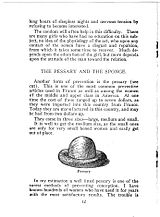
This page from Sanger's Family Limitation, 1917 edition, describes a cervical cap.
In 1917, she started publishing the monthly periodical Birth Control Review.[note 4]
On October 16, 1916, Sanger opened a family planning and birth control clinic at 46 Amboy St. in the Brownsville neighborhood of Brooklyn, the first of its kind in the United States.[26] Nine days after the clinic opened, Sanger was arrested. Sanger's bail was set at $500 and she went back home. Sanger continued seeing some women in the clinic until the police came a second time. This time Sanger and her sister, Ethyl, were arrested for breaking a New York state law that prohibited distribution of contraceptives, Sanger was also charged with running a public nuisance.[27] Sanger and Ethyl went to trial in January 1917.[28] Sanger was convicted; the trial judge held that women did not have "the right to copulate with a feeling of security that there will be no resulting conception."[29] Sanger was offered a more lenient sentence if she promised to not break the law again, but she replied: "I cannot respect the law as it exists today."[30] For this, she was sentenced to 30 days in a workhouse.[30] An initial appeal was rejected, but in a subsequent court proceeding in 1918, the birth control movement won a victory when Judge Frederick E. Crane of the New York Court of Appeals issued a ruling which allowed doctors to prescribe contraception.[31] The publicity surrounding Sanger's arrest, trial, and appeal sparked birth control activism across the United States, and earned the support of numerous donors, who would provide her with funding and support for future endeavors.[32]
Sanger became estranged from her husband in 1913, and the couple's divorce was finalized in 1921.[33] Sanger's second husband was Noah Slee. He followed Sanger around the world and provided much of Sanger's financial assistance. The couple got married in September 1922, but the public did not know about it until February 1924. They supported each other with their pre-commitments.[34]
American Birth Control League

Sanger published the Birth Control Review from 1917 to 1929.[note 5]
We hold that children should be (1) Conceived in love; (2) Born of the mother's conscious desire; (3) And only begotten under conditions which render possible the heritage of health. Therefore we hold that every woman must possess the power and freedom to prevent conception except when these conditions can be satisfied.Sanger's appeal of her conviction for the Brownsville clinic secured a 1918 court ruling that exempted physicians from the law that prohibited the distribution of contraceptive information to women—provided it was prescribed for medical reasons—she established the Clinical Research Bureau (CRB) in 1923 to exploit this loophole.[8][37] The CRB was the first legal birth control clinic in the United States, and it was staffed entirely by female doctors and social workers.[38] The clinic received a large amount of funding from John D. Rockefeller Jr. and his family, which continued to make donations to Sanger's causes in future decades, but generally made them anonymously to avoid public exposure of the family name,[39] and to protect family member Nelson Rockefeller's political career since openly advocating birth control could have led to the Catholic Church opposing him politically.[40] John D. Rockefeller Jr. donated five thousand dollars to her American Birth Control League in 1924 and a second time in 1925.[41] In 1922, she traveled to China, Korea, and Japan. In China she observed that the primary method of family planning was female infanticide, and she later worked with Pearl Buck to establish a family planning clinic in Shanghai.[42] Sanger visited Japan six times, working with Japanese feminist Kato Shidzue to promote birth control.[43] This was ironic since ten years earlier Sanger had accused Katō of murder and praised an attempt to kill her.[44]
In 1926, Sanger gave a lecture on birth control to the women's auxiliary of the Ku Klux Klan in Silver Lake, New Jersey.[45] She described it as "one of the weirdest experiences I had in lecturing," and added that she had to use only "the most elementary terms, as though I were trying to make children understand."[45] Sanger's talk was well received by the group, and as a result, "a dozen invitations to similar groups were proffered."[45]
In 1928, conflict within the birth control movement leadership led Sanger to resign as the president of the ABCL and take full control of the CRB, renaming it the Birth Control Clinical Research Bureau (BCCRB), marking the beginning of a schism in the movement that would last until 1938.[46]
Sanger invested a great deal of effort communicating with the general public. From 1916 onward, she frequently lectured—in churches, women's clubs, homes, and theaters—to workers, churchmen, liberals, socialists, scientists, and upper-class women.[47] She wrote several books in the 1920s which had a nationwide impact in promoting the cause of birth control. Between 1920 and 1926, 567,000 copies of Woman and the New Race and The Pivot of Civilization were sold.[48] She also wrote two autobiographies designed to promote the cause. The first, My Fight for Birth Control, was published in 1931 and the second, more promotional version, Margaret Sanger: An Autobiography, was published in 1938.
During the 1920s, Sanger received hundreds of thousands of letters, many of them written in desperation by women begging for information on how to prevent unwanted pregnancies. [49] [50] Five hundred of these letters were compiled into the 1928 book, Motherhood in Bondage.[51] [52]
Planned Parenthood era
Main article: Planned Parenthood
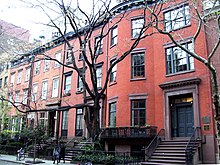
Sanger's Birth Control Clinical Research Bureau operated from this New York building from 1930 to 1973.
This 1936 contraception court victory was the culmination of Sanger's birth control efforts, and she took the opportunity, now in her late 50s, to move to Tucson, Arizona, intending to play a less critical role in the birth control movement. In spite of her original intentions, she remained active in the movement through the 1950s.[55]
In 1937, Sanger became chairman of the newly formed Birth Control Council of America, and attempted to resolve the schism between the ABCL and the BCCRB.[56] Her efforts were successful, and the two organizations merged in 1939 as the Birth Control Federation of America.[57][note 6] Although Sanger continued in the role of president, she no longer wielded the same power as she had in the early years of the movement, and in 1942, more conservative forces within the organization changed the name to Planned Parenthood Federation of America, a name Sanger objected to because she considered it too euphemistic.[58]
In 1946, Sanger helped found the International Committee on Planned Parenthood, which evolved into the International Planned Parenthood Federation in 1952, and soon became the world's largest non-governmental international family planning organization. Sanger was the organization's first president and served in that role until she was 80 years old.[59] In the early 1950s, Sanger encouraged philanthropist Katharine McCormick to provide funding for biologist Gregory Pincus to develop the birth control pill which was eventually sold under the name Enovid.[60]
Death
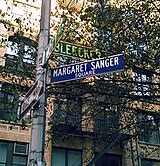
Margaret Sanger Square, at the intersection of Mott Street and Bleecker Street in Manhattan
Legacy
Long after her death, Sanger has continued to be regarded as a leading figure in the battle for American women's rights. Sanger's story has been the subject of several biographies, including an award-winning biography published in 1970 by David Kennedy, and is also the subject of several films, including Choices of the Heart: The Margaret Sanger Story.[63] Sanger's writings are curated by two universities: New York University's history department maintains the Margaret Sanger Papers Project,[64] and Smith College's Sophia Smith Collection maintains the Margaret Sanger Papers collection.[65]Sanger has been recognized with many important honors. In 1957, the American Humanist Association named her Humanist of the Year. Government authorities and other institutions have memorialized Sanger by dedicating several landmarks in her name, including a residential building on the Stony Brook University campus, a room in Wellesley College's library,[66] and Margaret Sanger Square in New York City's Greenwich Village.[67] In 1993, the Margaret Sanger Clinic—where she provided birth control services in New York in the mid twentieth century—was designated as a National Historic Landmark by the National Park Service.[68] In 1966, Planned Parenthood began issuing its Margaret Sanger Awards annually to honor "individuals of distinction in recognition of excellence and leadership in furthering reproductive health and reproductive rights."[69]
Many who are opposed to the legalization of abortion frequently condemn Sanger by questioning her fitness as a mother and criticizing her views on race, abortion, and eugenics.[70][71][note 8] In spite of such attacks, Sanger continues to be regarded as an icon for the American reproductive rights movement and woman's rights movement.
Controversies
Sexuality
While researching information on contraception Sanger read various treatises on sexuality in order to find information about birth control. She read The Psychology of Sex by the English psychologist Havelock Ellis and was heavily influenced by it.[72] While traveling in Europe in 1914, Sanger met Ellis.[73] Influenced by Ellis, Sanger adopted his view of sexuality as a powerful, liberating force.[74] This view provided another argument in favor of birth control, as it would enable women to fully enjoy sexual relations without the fear of an unwanted pregnancy.[75] Sanger also believed that sexuality, along with birth control, should be discussed with more candor.[74]However, Sanger was opposed to excessive sexual indulgence. She stated "every normal man and woman has the power to control and direct his sexual impulse. Men and women who have it in control and constantly use their brain cells thinking deeply, are never sensual."[76][77] Sanger said that birth control would elevate women away from a position of being an object of lust and elevate sex away from purely being for satisfying lust, saying that birth control "denies that sex should be reduced to the position of sensual lust, or that woman should permit herself to be the instrument of its satisfaction."[78] Sanger wrote that masturbation was dangerous. She stated: "In my personal experience as a trained nurse while attending persons afflicted with various and often revolting diseases, no matter what their ailments, I never found any one so repulsive as the chronic masturbator. It would not be difficult to fill page upon page of heart-rending confessions made by young girls, whose lives were blighted by this pernicious habit, always begun so innocently."[79] She believed that women had the ability to control their sexual impulses, and should utilize that control to avoid sex outside of relationships marked by "confidence and respect." She believed that exercising such control would lead to the "strongest and most sacred passion."[80] However, Sanger was not opposed to homosexuality and praised Ellis for clarifying "the question of homosexuals... making the thing a—not exactly a perverted thing, but a thing that a person is born with different kinds of eyes, different kinds of structures and so forth... that he didn't make all homosexuals perverts—and I thought he helped clarify that to the medical profession and to the scientists of the world as perhaps one of the first ones to do that."[81] Sanger believed sex should be discussed with more candor, and praised Ellis for his efforts in this direction. She also blamed the suppression of discussion about it on Christianity.[81]
Eugenics
As part of her efforts to promote birth control, Sanger found common cause with proponents of eugenics, believing that they both sought to "assist the race toward the elimination of the unfit."[82] Sanger was a proponent of negative eugenics, which aims to improve human hereditary traits through social intervention by reducing the reproduction of those who were considered unfit. Sanger's eugenic policies included an exclusionary immigration policy, free access to birth control methods and full family planning autonomy for the able-minded, and compulsory segregation or sterilization for the profoundly retarded.[83][84] In her book The Pivot of Civilization, she advocated coercion to prevent the "undeniably feeble-minded" from procreating.[85] Although Sanger supported negative eugenics, she asserted that eugenics alone was not sufficient, and that birth control was essential to achieve her goals.[86][87][88]In contrast with eugenicist William Robinson, who advocated euthanasia for the unfit,[note 9] Sanger wrote, "we [do not] believe that the community could or should send to the lethal chamber the defective progeny resulting from irresponsible and unintelligent breeding."[89] Similarly, Sanger denounced the aggressive and lethal Nazi eugenics program.[84] In addition, Sanger believed the responsibility for birth control should remain in the hands of able-minded individual parents rather than the state, and that self-determining motherhood was the only unshakable foundation for racial betterment.[86][90]
Sanger also supported restrictive immigration policies. In "A Plan for Peace", a 1932 essay, she proposed a congressional department to address population problems. She also recommended that immigration exclude those "whose condition is known to be detrimental to the stamina of the race," and that sterilization and segregation be applied to those with incurable, hereditary disabilities.[83][84][91]
Race
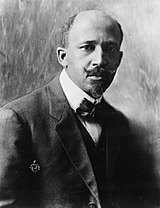
W. E. B. Du Bois served on the board of Sanger's Harlem clinic.[92]
Such attitudes did not keep her from collaborating with African-American leaders and professionals who saw a need for birth control in their communities. In 1929, James H. Hubert, a black social worker and leader of New York's Urban League, asked Sanger to open a clinic in Harlem.[95] Sanger secured funding from the Julius Rosenwald Fund and opened the clinic, staffed with black doctors, in 1930. The clinic was directed by a 15-member advisory board consisting of black doctors, nurses, clergy, journalists, and social workers. The clinic was publicized in the African-American press and in black churches, and it received the approval of W. E. B. Du Bois, founder of the NAACP.[96] She did not tolerate bigotry among her staff, nor would she tolerate any refusal to work within interracial projects.[97] Sanger's work with minorities earned praise from Martin Luther King, Jr., in his 1966 acceptance speech for the Margaret Sanger award.[98]
From 1939 to 1942 Sanger was an honorary delegate of the Birth Control Federation of America, which included a supervisory role—alongside Mary Lasker and Clarence Gamble—in the Negro Project, an effort to deliver birth control to poor black people.[99] Sanger wanted the Negro Project to include black ministers in leadership roles, but other supervisors did not. To emphasize the benefits of involving black community leaders, she wrote to Gamble "we do not want word to go out that we want to exterminate the Negro population and the minister is the man who can straighten out that idea if it ever occurs to any of their more rebellious members." This quote has been cited by Angela Davis to support her claims that Sanger wanted to exterminate black people.[100] However, New York University's Margaret Sanger Papers Project, argues that in writing that letter, "Sanger recognized that elements within the black community might mistakenly associate the Negro Project with racist sterilization campaigns in the Jim Crow South, unless clergy and other community leaders spread the word that the Project had a humanitarian aim."[101]
Freedom of speech
Sanger opposed censorship throughout her career, with a zeal comparable to her support for birth control. Sanger grew up in a home where iconoclastic orator Robert Ingersoll was admired.[102] During the early years of her activism, Sanger viewed birth control primarily as a free-speech issue, rather than as a feminist issue, and when she started publishing The Woman Rebel in 1914, she did so with the express goal of provoking a legal challenge to the Comstock laws banning dissemination of information about contraception.[21] In New York, Emma Goldman introduced Sanger to members of the Free Speech League, such as Edward Bliss Foote and Theodore Schroeder, and subsequently the League provided funding and advice to help Sanger with legal battles.[103]Over the course of her career, Sanger was arrested at least eight times for expressing her views during an era in which speaking publicly about contraception was illegal.[104] Numerous times in her career, local government officials prevented Sanger from speaking by shuttering a facility or threatening her hosts.[105] In Boston in 1929, city officials under the leadership of James Curley threatened to arrest her if she spoke—so she turned the threat to her advantage and stood on stage, silent, with a gag over her mouth, while her speech was read by Arthur M. Schlesinger, Sr.[106]
Abortion
Sanger's family planning advocacy always focused on contraception, rather than abortion.[107][note 10] It was not until the mid-1960s, after Sanger's death, that the reproductive rights movement expanded its scope to include abortion rights as well as contraception.[note 11] Sanger was opposed to abortions, both because they were dangerous for the mother in the early 20th century and because she believed that life should not be terminated after conception. In her book Woman and the New Race, she wrote: "while there are cases where even the law recognizes an abortion as justifiable if recommended by a physician, I assert that the hundreds of thousands of abortions performed in America each year are a disgrace to civilization."[110]Historian Rodger Streitmatter concluded that Sanger's opposition to abortion stemmed from concerns for the dangers to the mother, rather than moral concerns.[111] However, in her 1938 autobiography, Sanger noted that her opposition to abortion was based on the taking of life: "[In 1916] we explained what contraception was; that abortion was the wrong way no matter how early it was performed it was taking life; that contraception was the better way, the safer way—it took a little time, a little trouble, but was well worth while in the long run, because life had not yet begun."[112] And in her book Family Limitation, Sanger wrote that "no one can doubt that there are times when an abortion is justifiable but they will become unnecessary when care is taken to prevent conception. This is the only cure for abortions."[113]
Works
- Books and pamphlets
- What Every Mother Should Know – Originally published in 1911 or 1912, based on a series of articles Sanger published in 1911 in the New York Call, which were, in turn, based on a set of lectures Sanger gave to groups of Socialist party women in 1910–1911.[114] Multiple editions published through the 1920s, by Max N. Maisel and Sincere Publishing, with the title What Every Mother Should Know, or how six little children were taught the truth ... Online (1921 edition, Michigan State University)
- Family Limitation – Originally published 1914 as a 16-page pamphlet; also published in several later editions. Online (1917, 6th edition, Michigan State University)
- What Every Girl Should Know – Originally published 1916 by Max N. Maisel; 91 pages; also published in several later editions. Online (1920 edition); Online (1922 ed., Michigan State University)
- The Case for Birth Control: A Supplementary Brief and Statement of Facts – May 1917, published to provide information to the court in a legal proceeding. Online (Google Books)
- Woman and the New Race, 1920, Truth Publishing, foreword by Havelock Ellis. Online (Harvard University); Online (Project Gutenberg); Online (Google Books)
- Debate on Birth Control – 1921, text of a debate between Sanger, Theodore Roosevelt, Winter Russell, George Bernard Shaw, Robert L. Wolf, and Emma Sargent Russell. Published as issue 208 of Little Blue Book series by Haldeman-Julius Co. Online (1921, Michigan State University)
- The Pivot of Civilization, 1922, Brentanos. Online (1922, Project Gutenberg); Online (1922, Google Books)
- Motherhood in Bondage, 1928, Brentanos. Online (Google Books).
- My Fight for Birth Control, 1931, New York: Farrar & Rinehart
- An Autobiography. New York, NY: Cooper Square Press. 1938. ISBN 0-8154-1015-8.
- Fight for Birth Control, 1916, New York] [2] (The Library of Congress)
- Birth Control A Parent's Problem or Women's?" The Birth Control Review, Mar. 1919, 6-7.
- Periodicals
- The Woman Rebel – Seven issues published monthly from March 1914 to August 1914. Sanger was publisher and editor.
- Birth Control Review – Published monthly from February 1917 to 1940. Sanger was Editor until 1929, when she resigned from the ABCL.[115] Not to be confused with Birth Control News, published by the London-based Society for Constructive Birth Control and Racial Progress.
- Collections and anthologies
- Sanger, Margaret, The Selected Papers of Margaret Sanger, Volume 1: The Woman Rebel, 1900–1928, Esther Katz, Cathy Moran Hajo, Peter Engelman (eds), University of Illinois Press, 2003
- Sanger, Margaret, The Selected Papers of Margaret Sanger, Volume 2: Birth Control Comes of Age, 1928–1939, Esther Katz, Cathy Moran Hajo, Peter Engelman (eds), University of Illinois Press, 2007
- Sanger, Margaret, The Selected Papers of Margaret Sanger, Volume 3: The Politics of Planned Parenthood, 1939–1966, Esther Katz, Cathy Moran Hajo, Peter Engelman (eds), University of Illinois Press, 2010
- Works by Margaret Sanger at Project Gutenberg
- The Margaret Sanger Papers at Smith College
- The Margaret Sanger Papers Project at New York University
- McElderry, Michael J. (1976). "Margaret Sanger: A Register of Her Papers in the Library of Congress". Manuscript Division, Library of Congress. Archived from the original on 2009-03-29. Retrieved 2009-03-30.
- Correspondence between Sanger and McCormick, from The Pill documentary movie; supplementary material, PBS, American Experience (producers). online.
See also
- History of women in the United States
- Mary Ware Dennett
- Emma Goldman
- Margaret Mead
- Upton Sinclair
- Choices of the Heart: The Margaret Sanger Story
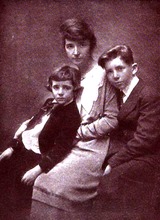

No comments:
Post a Comment
Please leave a comment-- or suggestions, particularly of topics and places you'd like to see covered